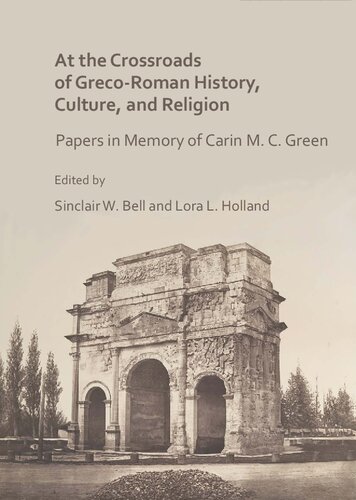At the Crossroads of Greco-Roman History, Culture, and Religion: Papers in Memory of Carin M. C. Green


At the Crossroads of Greco-Roman History, Culture, and Religion' brings together recent research from a range of upcoming and well-established scholars to demonstrate the richness of the cross-cultural exchange of ideas around the ancient Mediterranean along with the reception of and continuing dialogues with these ideas in the medieval and modern worlds. The crossroads theme both honours the memory of our late colleague and friend Carin M. C. Green, who published an important book on the cult of Diana—one of whose aspects was Trivia, the goddess of crossroads—and emphasizes how each encounter of new topic or genre forces the reader to pause and think before proceeding down the new path. The contents are arranged accordingly under three headings: (1) Greek philosophy, history, and historiography; (2) Latin literature, history, and historiography; and (3) Greco-Roman material culture, religion, and literature. These papers also coincide in myriad ways across the three headings, tracing themes such as friendship, leadership, and the reception of ideas in the arenas of philosophy, historiography, manuscript studies, poetry, medicine, art, and war. Within this delimited framework, the volume’s diversity of topics and approaches to a range of genres in the Greco- Roman world is intended both to appeal to the general scholar with varied interests and to offer students a wide scope through which to consider those genres.<br><br>Table of Contents<br><br>Bibliography of Works by Carin M. C. Green<br><br>Introduction – by Lora L. Holland and Sinclair W. Bell<br><br>Crossroads 1: Greek Philosophy, History, and Historiography<br><br>1. Herakles’ Thirteenth Labor – by Svetla Slaveva-Griffin<br><br>2. Thucydides’ Verdict on Nicias (7.86.5) and the Paradigm of Tragedy – by Frances B. Titchener and Mark L. Damen<br><br>3. 'Men, Friends': The Sociological Mechanics of Xenophontic Leaders Winning Subordinates as Friends – by Robert Holschuh Simmons<br><br>4. (Pre)historiography and Periegesis: Pausanias’ Description of Mycenae for a Roman Audience – by Lynne A. Kvapil<br><br>Crossroads 2: Latin Literature, History, and Historiography<br><br>5. Catullus and the Personal Empire – by Christopher Nappa<br><br>6. Ex opportunitate loci: Understanding Geographic Advantage (Sallust, Bellum Iugurthinum 48.1–53.8) – by Andrew Montgomery<br><br>7. Sallust’s Allobrogian Envoys – by Kathryn Williams<br><br>8. Horace, Satires 1.7 and the urbanissimus iocus – by John Svarlien<br><br>9. Ovid among the Barbarians: Tristia 5.7a and 5.7b – by Helena Dettmer<br><br>10. The Introduction of Characters in Petronius – by Martha Habash<br><br>11. Playing the Victor: Triumphal Anxiety in Neronian Satire – by Mark Thorne<br><br>Crossroads 3: Greco-Roman Material Culture, Religion, and Literature<br><br>12. Theocritus’ First Idyll and Vergil’s First Eclogue: Two New Translations – by Jane Wilson Joyce<br><br>13. The Popularity of Hercules in Pre-Roman Central Italy – by Karl Galinsky<br><br>14. Spolia as Strategy in the Early Roman Empire: Reused Statues in Augustan Rome – by Brenda Longfellow<br><br>15. Ovid and the Legend of Capella (Fasti 5.111–128) – by John F. Miller<br><br>16. Galen and the Culture of Dissection – by Lesley Dean-Jones<br><br>17. Warts and All: The Paratexts in the Iowa Lucan – by Samuel J. Huskey<br><br>18. Three Editions of Lucan’s Bellum Civile – by Mark Morford
Title Page
Copyright Page
Carin M. C. Green (30 March 1948–2 July 2015).
University Relations Slides, the University of Iowa Libraries, Iowa City, Iowa,
inv. nr. fs-2-01-2398-12-ts-2.
Contributors
Contents
Abbreviations
Preface
Sinclair W. Bell
Acknowledgments
Bibliography of Works by Carin M. C. Green
Introduction
Lora L. Holland and Sinclair W. Bell
Herakles’ Thirteenth Labor
Svetla Slaveva-Griffin
Thucydides’ Verdict on Nicias (7.86.5) and the Paradigm of Tragedy
Frances B. Titchener and Mark L. Damen
“Men, Friends”
(Pre)historiography and Periegesis
Catullus and the Personal Empire
Christopher Nappa
Ex opportunitate loci
Sallust’s Allobrogian Envoys
Kathryn Williams
Horace, Satires 1.7 and the urbanissimus iocus
John Svarlien
Ovid among the Barbarians: Tristia 5.7a and 5.7b
Helena Dettmer
Figure 9.1. Structure of Tristia 5.7a
Figure 9.2. Ring structure of lines 25–42 of Tristia 5.7b
Figure 9.3. Ring structure of lines 43–68 of Tristia 5.7b
9.4. Ring structure framing the central section of Tristia 5.7b
The Introduction of Characters in Petronius
Martha Habash
Playing the Victor: Triumphal Anxiety in Neronian Satire
Mark Thorne
Theocritus’ First Idyll and Vergil’s First Eclogue: Two New Translations
Jane Wilson Joyce
The Popularity of Hercules in Pre-Roman Central Italy
Karl Galinsky
Figure 13.1a–c. Hercules in assault. After Campanelli et al. 1997, 144, figs. 7–9.
Figure 13.2. Hercules with stylized lion skin. After Colonna 1970, fig. 386.
Figure 13.3. Votive statuette of Hellenized Hercules. After Campanelli et al. 1997, 147, fig. 20.
Figure 13.4. Lion skin and Hercules. After Colonna 1970, fig. 374.
Figure 13.5. Hercules in repose. After Campanelli et al. 1997, 147, fig. 14.
Figure 13.6. Hercules of Cafeo. After Bonacasa 2013, 69 [fig. 37].
13.7. Votive statuette of Hercules Farnese type. After Moreno 1989, pl. VI.
13.8. Hercules with attributes of Dionysus. After Colonna 1970, fig. 476.
Spolia as Strategy in the Early Roman Empire
Ovid and the Legend of Capella (Fasti 5.111–128)
John F. Miller
Figure 15.1. Fountain frieze, marble, second century CE. Musei Vaticani inv. 9510. Photo: Vatican Museums, published with permission.
Galen and the Culture of Dissection
Lesley Dean-Jones
Warts and All: The Paratexts in the Iowa Lucan
Samuel J. Huskey
Three Editions of Lucan’s Bellum Civile
Mark Morford

امتیاز شما به این منبع
یادداشت های من
هنوز یادداشتی ثبت نشده است.
آمار
- بازدید: 11
تعداد نقد و نظر: 0
تعداد مورد علاقه: 0

دسترسی به این صفحه



